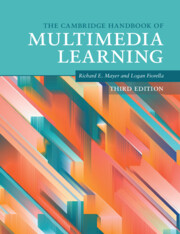Book contents
- The Cambridge Handbook of Multimedia Learning
- The Cambridge Handbook of Multimedia Learning
- Copyright page
- Contents
- Figures
- Tables
- Contributors
- Preface
- Acknowledgments
- Part I Background
- Part II Theoretical Foundations
- Part III Basic Principles of Multimedia Learning
- Part IV Principles for Reducing Extraneous Processing in Multimedia Learning
- 14 Principles for Reducing Extraneous Processing in Multimedia Learning
- 15 The Split-Attention Principle in Multimedia Learning
- 16 The Redundancy Principle in Multimedia Learning
- 17 The Signaling (or Cueing) Principle in Multimedia Learning
- 18 The Worked Example Principle in Multimedia Learning
- Part V Principles for Managing Essential Processing in Multimedia Learning
- Part VI Principles Based on Social and Affective Features of Multimedia Learning
- Part VII Principles Based on Generative Activity in Multimedia Learning
- Part VIII Multimedia Learning with Media
- Author Index
- Subject Index
- References
15 - The Split-Attention Principle in Multimedia Learning
from Part IV - Principles for Reducing Extraneous Processing in Multimedia Learning
Published online by Cambridge University Press: 19 November 2021
- The Cambridge Handbook of Multimedia Learning
- The Cambridge Handbook of Multimedia Learning
- Copyright page
- Contents
- Figures
- Tables
- Contributors
- Preface
- Acknowledgments
- Part I Background
- Part II Theoretical Foundations
- Part III Basic Principles of Multimedia Learning
- Part IV Principles for Reducing Extraneous Processing in Multimedia Learning
- 14 Principles for Reducing Extraneous Processing in Multimedia Learning
- 15 The Split-Attention Principle in Multimedia Learning
- 16 The Redundancy Principle in Multimedia Learning
- 17 The Signaling (or Cueing) Principle in Multimedia Learning
- 18 The Worked Example Principle in Multimedia Learning
- Part V Principles for Managing Essential Processing in Multimedia Learning
- Part VI Principles Based on Social and Affective Features of Multimedia Learning
- Part VII Principles Based on Generative Activity in Multimedia Learning
- Part VIII Multimedia Learning with Media
- Author Index
- Subject Index
- References
Summary
The split-attention principle states that when designing instruction, including multimedia instruction, it is important to avoid materials that require learners to split their attention between multiple sources of information. Instead, materials should be formatted so that disparate sources of information are physically and temporally integrated, thus obviating the need for learners to engage in mental integration. By eliminating the need to mentally integrate multiple sources of information, extraneous cognitive load is reduced, freeing resources for learning (germane cognitive load). This chapter provides the theoretical rationale, based on cognitive load theory, for the split-attention principle, and describes the major experiments that establish the validity of the principle, identifies the conditions under which it is most likely to occur, and indicates the instructional design implications when dealing with multimedia materials.
Keywords
- Type
- Chapter
- Information
- The Cambridge Handbook of Multimedia Learning , pp. 199 - 211Publisher: Cambridge University PressPrint publication year: 2021
References
- 4
- Cited by



